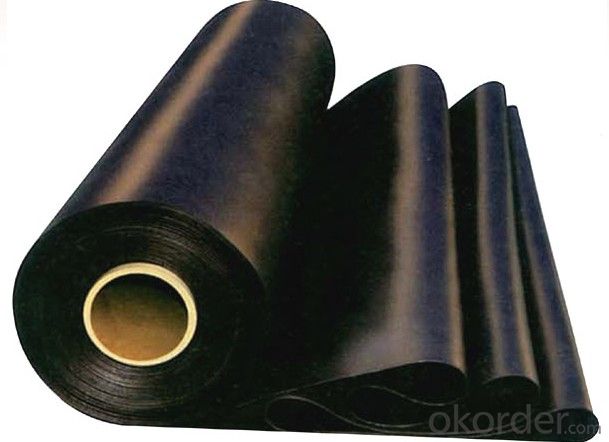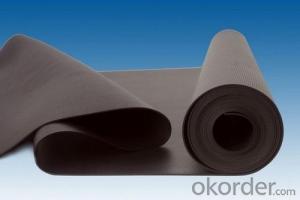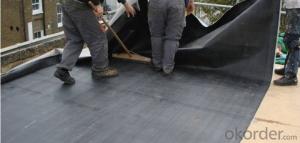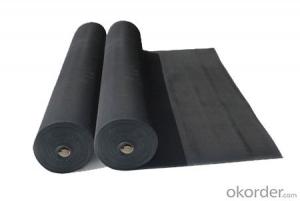EPDM Waterproofing Membrane for Construction
- Loading Port:
- China main port
- Payment Terms:
- TT OR LC
- Min Order Qty:
- 5000 m²
- Supply Capability:
- 100000 m²/month
OKorder Service Pledge
OKorder Financial Service
You Might Also Like
Introduction for EPDM Waterproofing Membrane:
EPDM (TBD) self adhesive rubber waterproofing membrane is used (OP) rubber waterproofing membrane as based materials, Surface coating Nano-polymer adhesive glue squeeze a new high-strength self adhesive waterproofing.
Characteristic of EPDM Waterproofing Membrane:
1>Excellent anti-aging performance, service life up to 50 years
2>Working well with in -40°C to 100°C,it can be constructed with a single layer in ambient temperature. 3>Waterproofing on various kinds of underground project,industrial of civil buildings and structures. 4>high extension rate, high tensile strength, small size changes at heat treatment
5>Good plant roots penetrability resistance and can be made waterproofing layer of planting roof
6>Special modified molecular structure ,effectively resolving the current domestic and foreign glue joint problem . 7>Good low temperature flexibility, and good performance of adapting to ambient temperature changes. 8>Convenient application ,solid joint, no environment pollution
9>chemical corrosion Resistance, can be used for special occasions
Application Range of EPDM Waterproofing Membrane:
EPDM (TBD) selfadhesive waterproofing membrane used in roofing projects, exposed roofing, building foundations, basements, storage tanks, subways, tunnels, supermarkets, airports and other buildings waterproof.
Item | Thickness(mm) | Width(mm) | Length(m) | Color |
1.0—2.0 | 1200 | 20 | Black | |
Deviation | -1 +15 | --1 | Multicolor |
FAQ of Waterproofing Membrane
a.Can we get some samples before place order?
Answer: We can send the free samples to you by freight collect.
b.How many years can your PVC membrane guarantee?
Answer: We will guarantee the quality for 5 years at least.
c.Which countries you ever export the product?
Answer: We export the PVC membrane to South Africa, Middle east and even European countries.

- Q:How does a waterproofing membrane perform in areas with heavy foot traffic?
- A protective barrier against moisture and water penetration is the purpose of a waterproofing membrane in various applications. The performance of a waterproofing membrane is crucial in areas with heavy foot traffic. In such areas, the membrane's durability and strength become essential factors. A waterproofing membrane engineered specifically for heavy foot traffic can withstand the constant stress and pressure exerted by people walking, running, or using heavy equipment. Maintaining its integrity and preventing water or moisture from seeping through is one way a waterproofing membrane excels in areas with heavy foot traffic. It acts as a reliable shield, ensuring the underlying structure stays dry and protected. This is particularly important in spaces like balconies, terraces, or concrete walkways where water infiltration can cause structural damage, corrosion, or mold growth. Furthermore, a suitable waterproofing membrane for heavy foot traffic areas should possess excellent abrasion resistance. This means it can endure the friction and wear caused by frequent foot traffic without deteriorating or losing its waterproofing properties. The membrane should resist damage from shoes, heels, or other objects that may come into contact with its surface. Moreover, a waterproofing membrane for heavy foot traffic areas should be slip-resistant to guarantee the safety of individuals walking on it. It should provide sufficient traction and grip, even when wet, to prevent accidents or injuries. This is especially vital in spaces like swimming pool decks or commercial buildings where the risk of slipping is higher. In conclusion, a waterproofing membrane designed for heavy foot traffic areas performs by effectively sealing the surface, preventing water infiltration, and protecting the underlying structure. It should possess durability, strength, abrasion resistance, and slip resistance to ensure optimal performance and safety in areas subjected to heavy foot traffic.
- Q:How much does a waterproofing membrane cost?
- The cost of a waterproofing membrane can vary depending on several factors. The type of membrane, the size of the area to be waterproofed, and the complexity of the installation can all affect the price. On average, the cost of a waterproofing membrane can range from $1 to $5 per square foot. However, this is just a rough estimate and the actual cost can be higher or lower based on the aforementioned factors. For example, a basic sheet membrane made of PVC or EPDM might be on the lower end of the price range, while a liquid-applied membrane or a more advanced system like a bentonite clay membrane can be on the higher end. Additionally, the size of the area to be waterproofed will impact the cost. Larger areas will require more materials, labor, and time, which can increase the overall price. Complexity of the installation is another factor to consider. If the area is hard to access or requires extensive preparation work, such as removing existing materials or repairing cracks, the cost may be higher. It is recommended to consult with a professional waterproofing contractor who can assess your specific needs, provide an accurate estimate, and recommend the most suitable waterproofing membrane for your project.
- Q:Can a waterproofing membrane be used for chemical storage facilities?
- Yes, a waterproofing membrane can be used for chemical storage facilities. Waterproofing membranes are designed to create a barrier against water and moisture, and they can also provide protection against chemical spills and leaks. These membranes are typically made from durable materials such as PVC or EPDM, which have excellent resistance to various chemicals. Additionally, waterproofing membranes can be applied to various surfaces including concrete, metal, and even existing chemical storage tanks. By using a waterproofing membrane, the facility can prevent water ingress, minimize the risk of corrosion, and ensure the integrity of the chemical storage area. It is important to select a waterproofing membrane that is specifically designed and tested for chemical resistance to ensure optimal performance and safety in such facilities.
- Q:Can a waterproofing membrane be used for soundproofing purposes?
- To some extent, a waterproofing membrane can serve the purpose of soundproofing as well. While its primary function is to prevent water from seeping through, it also has the ability to minimize sound transmission. Typically, waterproofing membranes are constructed using materials that possess excellent acoustic properties, such as rubber or a combination of rubber and asphalt. These materials have the capability to absorb and muffle sound waves, resulting in a reduction in noise that can penetrate walls or floors. However, it's important to note that the soundproofing capabilities of a waterproofing membrane may not be as substantial as those of specialized soundproofing materials like acoustic panels or insulation. Therefore, if soundproofing is the main objective, it is advisable to consider utilizing dedicated soundproofing solutions in conjunction with or instead of a waterproofing membrane.
- Q:Can a waterproofing membrane be used for underground utility tunnels?
- Yes, a waterproofing membrane can be used for underground utility tunnels. A waterproofing membrane is a thin layer of material that is applied to the surface of a structure to prevent the penetration of water or moisture. It is commonly used in construction to protect buildings and structures from water damage. In the case of underground utility tunnels, where there is a high risk of water infiltration due to the surrounding soil and groundwater, a waterproofing membrane can be extremely beneficial. It can provide an effective barrier against water, preventing it from entering the tunnel and causing damage to the utilities inside. There are various types of waterproofing membranes available, including sheet membranes, liquid membranes, and spray-applied membranes. These membranes are typically made from materials such as asphalt, modified bitumen, polyurethane, or rubberized asphalt. They are designed to be durable, flexible, and resistant to water and other environmental factors. Before applying a waterproofing membrane to an underground utility tunnel, proper surface preparation is essential. The surface should be cleaned, free of any debris, and in good condition. The membrane should then be installed according to the manufacturer's instructions, ensuring that all seams and joints are properly sealed to create a continuous waterproofing barrier. It is important to note that waterproofing membranes are not a standalone solution for underground utility tunnels. They should be used in conjunction with other waterproofing measures, such as proper drainage systems, to ensure comprehensive water protection. Regular inspection and maintenance of the membrane are also necessary to check for any damage or deterioration and to address any issues promptly. In conclusion, a waterproofing membrane can be an effective solution for protecting underground utility tunnels from water infiltration. By creating a strong and durable barrier against moisture, it helps to maintain the integrity of the utilities and prolong the lifespan of the tunnel infrastructure.
- Q:Are waterproofing membranes resistant to gas and vapor transmission?
- Yes, waterproofing membranes are generally resistant to gas and vapor transmission. These membranes are designed to create a barrier that prevents the passage of liquid water, as well as gases and vapors, effectively ensuring the protection and integrity of the structure they are applied to.
- Q:Can a waterproofing membrane be used on brick walls?
- Yes, a waterproofing membrane can be used on brick walls. Brick is a porous material that can absorb water and moisture, making it susceptible to damage and deterioration over time. Applying a waterproofing membrane on brick walls helps to prevent water penetration and protect the structural integrity of the bricks. The membrane acts as a barrier, preventing water from seeping into the bricks while still allowing moisture to evaporate. This helps to keep the bricks dry and reduces the risk of water-related issues such as efflorescence, mold, and mildew. Additionally, a waterproofing membrane can also enhance the thermal insulation properties of the brick walls by reducing heat loss and improving energy efficiency. It is important to choose a waterproofing membrane specifically designed for use on masonry surfaces to ensure proper adhesion and long-lasting protection.
- Q:Can waterproofing membranes be used on foundation walls?
- Indeed, it is possible to utilize waterproofing membranes on foundation walls. These membranes possess a specific design that aims to impede the infiltration of water and are commonly employed on foundation walls to safeguard against moisture and water-related harm. Typically, these membranes consist of resilient materials like rubberized asphalt, thermoplastic, or PVC, which exhibit durability and resistance to water penetration. The installation of these membranes occurs on the outer side of the foundation walls, thereby serving as a highly efficient barrier against water, effectively averting its seepage into the basement or crawl space. Without a doubt, waterproofing membranes constitute an indispensable element in the realm of building construction, as they actively contribute to the preservation of the foundation's structural integrity, preventing adverse consequences such as water damage, mold growth, and foundation settlement.
- Q:What is the lifespan of a waterproofing membrane in extreme weather conditions?
- The lifespan of a waterproofing membrane in extreme weather conditions can vary depending on various factors such as the quality of the membrane, the intensity and duration of the weather conditions, and the maintenance and care provided to the membrane. In general, high-quality waterproofing membranes designed for extreme weather conditions can have a lifespan of 20-30 years or more. These membranes are typically made from durable materials such as modified bitumen, PVC, EPDM, or TPO, which are specifically engineered to withstand harsh weather elements. However, it is important to note that extreme weather conditions, such as heavy rain, intense sunlight, freezing temperatures, or strong winds, can accelerate the wear and tear of the membrane. For example, prolonged exposure to UV radiation can cause the membrane to degrade and lose its effectiveness over time. Regular maintenance and inspections are crucial to prolonging the lifespan of the waterproofing membrane in extreme weather conditions. By promptly addressing any signs of damage, such as cracks, tears, or leaks, and conducting regular cleaning and resealing, the membrane can be better protected against the harsh effects of extreme weather. Furthermore, proper installation techniques and following manufacturer's guidelines are essential to ensure the longevity of the waterproofing membrane. Hiring experienced professionals who are familiar with installing membranes in extreme weather conditions can greatly contribute to the durability and lifespan of the membrane. Ultimately, while a high-quality waterproofing membrane can withstand extreme weather conditions for several decades, it is important to monitor its condition regularly, provide proper care and maintenance, and promptly address any issues that arise to maximize its lifespan.
- Q:Can a waterproofing membrane be customized or tailored to specific project requirements?
- Indeed, specific project requirements can be met through the customization or tailoring of a waterproofing membrane. There are various types and materials available, including bituminous, synthetic, and liquid-applied membranes. These membranes can be adjusted or modified to suit the particular needs of a project. Customization involves factors such as the thickness or weight of the membrane, the type of reinforcement utilized, the application method, and the project's specific performance requirements. For instance, heavy traffic areas may require a thicker or more durable membrane to withstand substantial loads, while projects in harsh climates may necessitate a membrane with enhanced resistance to UV radiation or extreme temperatures. Moreover, the membrane can be tailored to different substrates or surfaces, such as concrete, metal, or wood, by utilizing compatible adhesives or primers. This ensures proper bonding and extends the lifespan of the waterproofing system. Furthermore, certain waterproofing membranes offer customizable options for color or appearance, enabling them to seamlessly blend with the overall aesthetic of the project. In conclusion, the customization of a waterproofing membrane allows for its specific design and engineering to cater to the unique requirements of each project. This ensures optimal performance and long-lasting protection against water damage.
1. Manufacturer Overview |
|
|---|---|
| Location | |
| Year Established | |
| Annual Output Value | |
| Main Markets | |
| Company Certifications | |
2. Manufacturer Certificates |
|
|---|---|
| a) Certification Name | |
| Range | |
| Reference | |
| Validity Period | |
3. Manufacturer Capability |
|
|---|---|
| a)Trade Capacity | |
| Nearest Port | |
| Export Percentage | |
| No.of Employees in Trade Department | |
| Language Spoken: | |
| b)Factory Information | |
| Factory Size: | |
| No. of Production Lines | |
| Contract Manufacturing | |
| Product Price Range | |
Send your message to us
EPDM Waterproofing Membrane for Construction
- Loading Port:
- China main port
- Payment Terms:
- TT OR LC
- Min Order Qty:
- 5000 m²
- Supply Capability:
- 100000 m²/month
OKorder Service Pledge
OKorder Financial Service
Similar products
New products
Hot products
Hot Searches
Related keywords



























